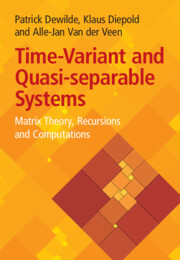Book contents
- Frontmatter
- Contents
- Preface
- Acknowledgements
- Part I Lectures on Basics with Examples
- 1 A First Example: Optimal Quadratic Control
- 2 Dynamical Systems
- 3 LTV (Quasi-separable) Systems
- 4 System Identification
- 5 State Equivalence, State Reduction
- 6 Elementary Operations
- 7 Inner Operators and External Factorizations
- 8 Inner−Outer Factorization
- 9 The Kalman Filter as an Application
- 10 Polynomial Representations
- 11 Quasi-separable Moore−Penrose Inversion
- Part II Further Contributions to Matrix Theory
- Appendix: Data Model and Implementations
- References
- Index
7 - Inner Operators and External Factorizations
from Part I - Lectures on Basics with Examples
Published online by Cambridge University Press: 24 October 2024
- Frontmatter
- Contents
- Preface
- Acknowledgements
- Part I Lectures on Basics with Examples
- 1 A First Example: Optimal Quadratic Control
- 2 Dynamical Systems
- 3 LTV (Quasi-separable) Systems
- 4 System Identification
- 5 State Equivalence, State Reduction
- 6 Elementary Operations
- 7 Inner Operators and External Factorizations
- 8 Inner−Outer Factorization
- 9 The Kalman Filter as an Application
- 10 Polynomial Representations
- 11 Quasi-separable Moore−Penrose Inversion
- Part II Further Contributions to Matrix Theory
- Appendix: Data Model and Implementations
- References
- Index
Summary
Several types of factorizations solve the main problems of system theory (e.g., identification, estimation, system inversion, system approximation, and optimal control). The factorization type depends on what kind of operator is factorized, and what form the factors should have. This and the following chapter are, therefore, devoted to the two main types of factorization: this chapter treats what is traditionally called coprime factorization, while the next is devoted to inner–outer factorization. Coprime factorization, here called “external factorization” for more generality, characterizes the system’s dynamics and plays a central role in system characterization and control issues. A remarkable result of our approach is the derivation of Bezout equations for time-variant and quasi-separable systems, obtained without the use of Euclidean divisibility theory. From a numerical point of view, all these factorizations reduce to recursively applied QR or LQ factorizations, applied on appropriately chosen operators.
Information
- Type
- Chapter
- Information
- Time-Variant and Quasi-separable SystemsMatrix Theory, Recursions and Computations, pp. 95 - 114Publisher: Cambridge University PressPrint publication year: 2024
